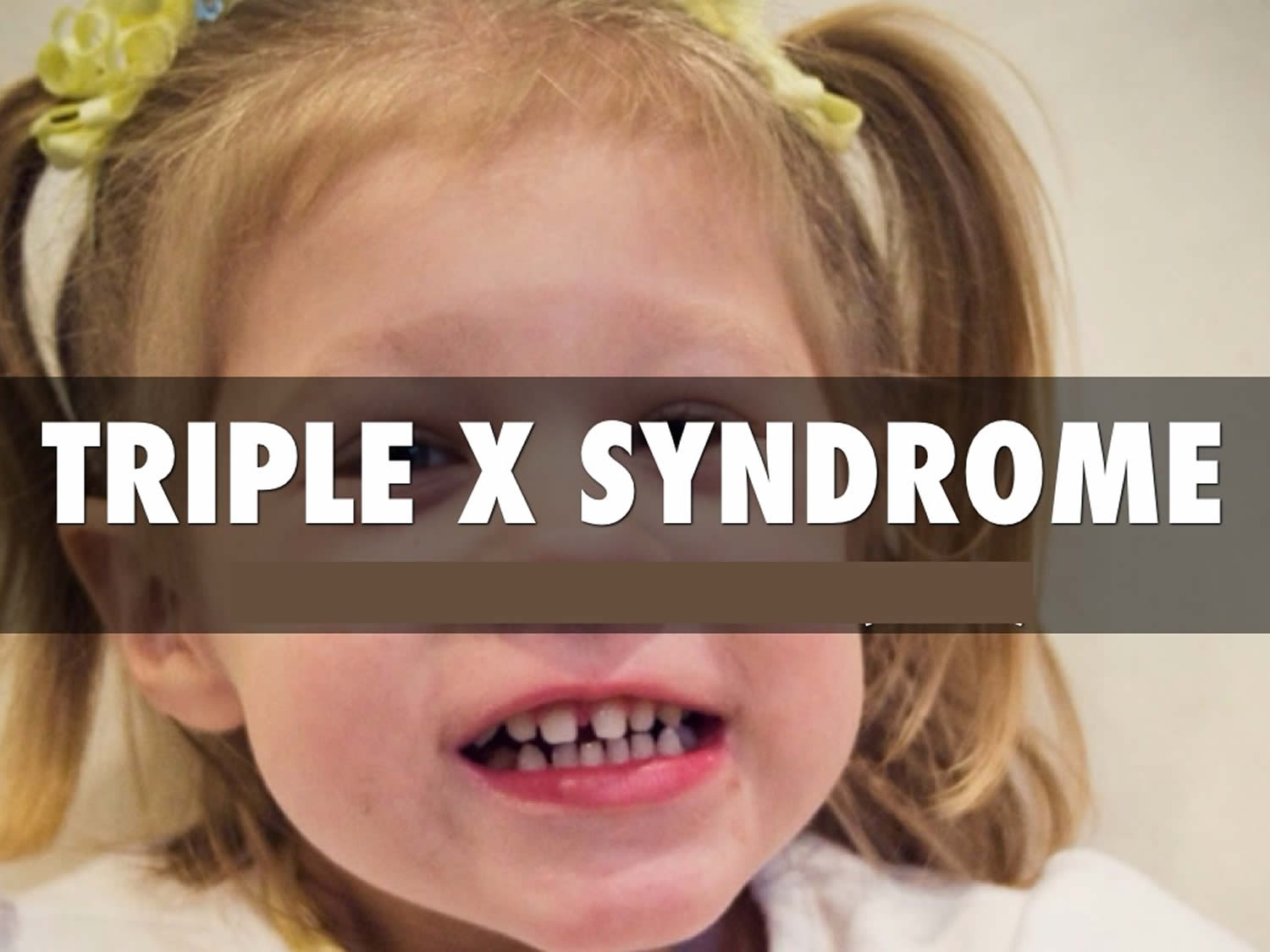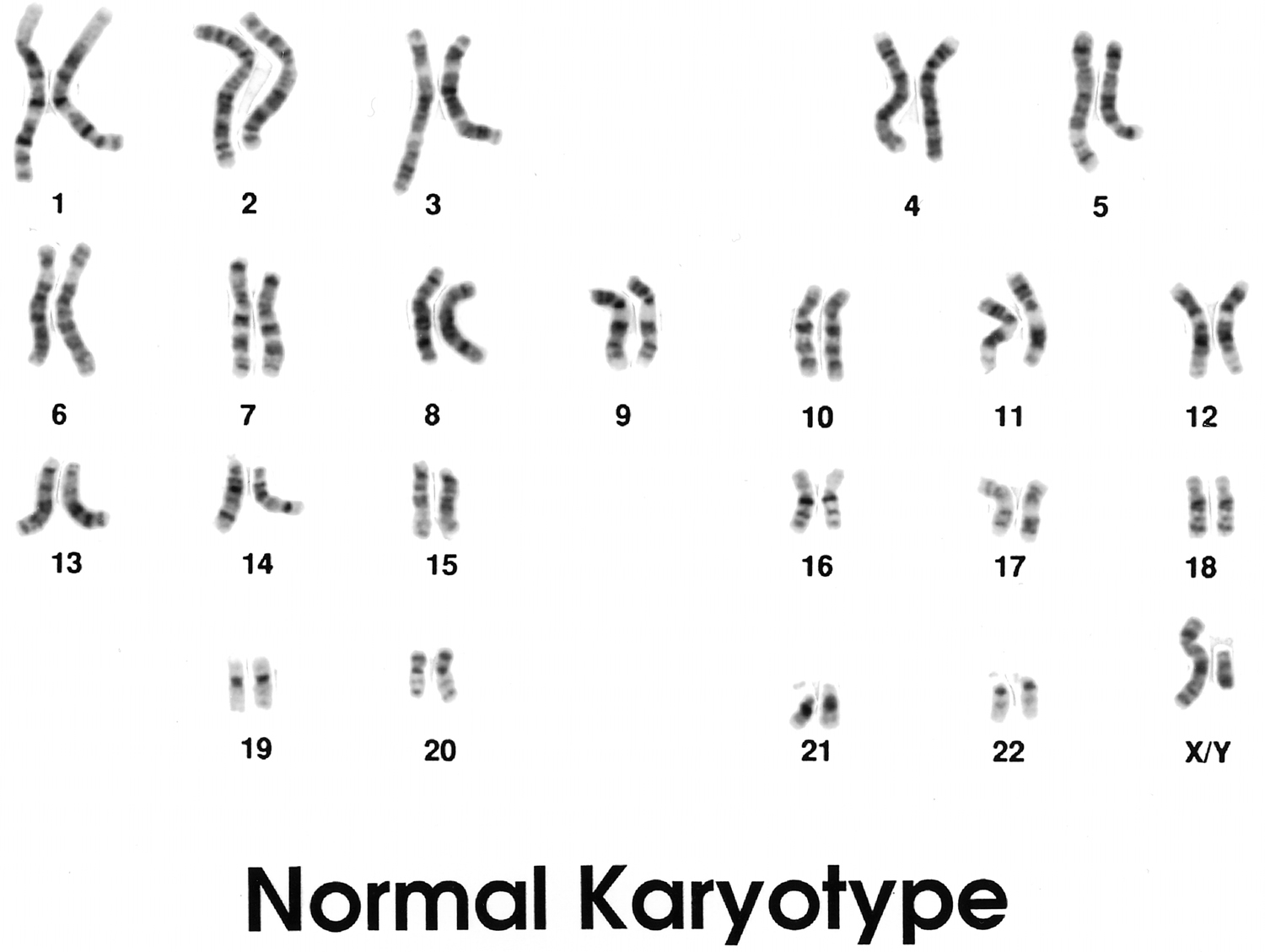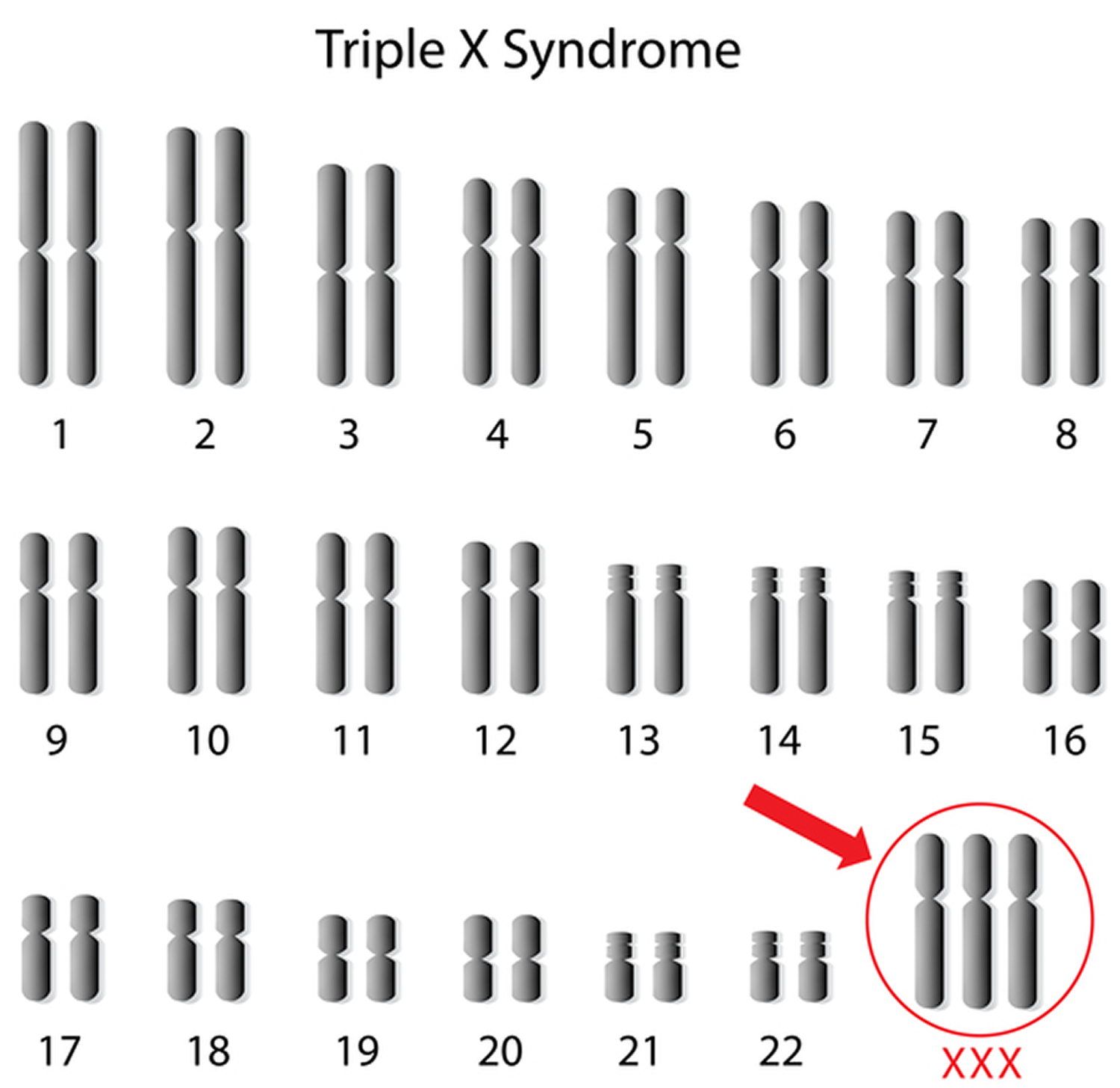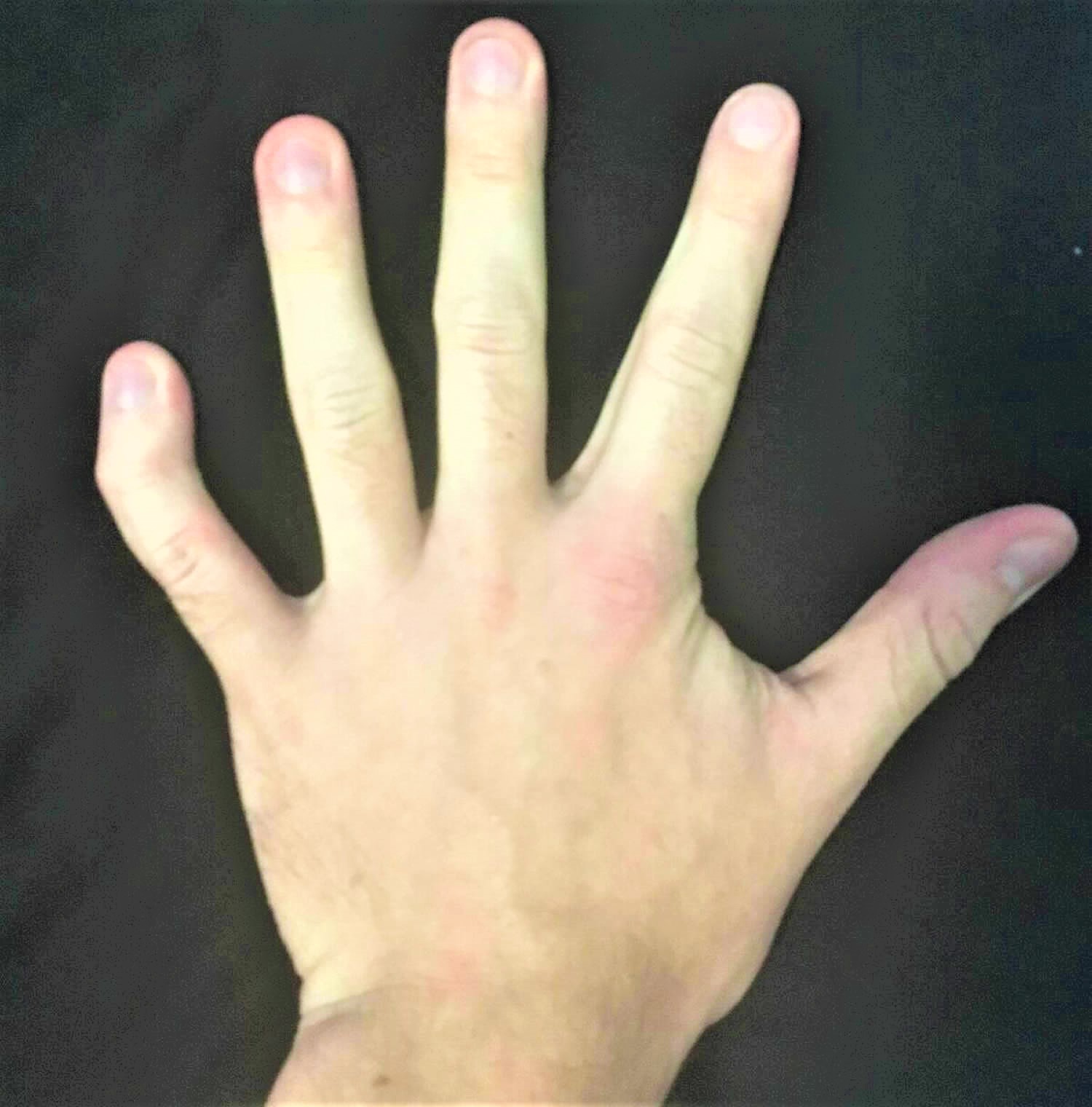What is triple x syndrome
Triple X syndrome, also called trisomy X or 47,XXX, is characterized by the presence of an additional X chromosome in each of a female’s cells. Although females with this condition may be taller than average, this chromosomal change typically causes no unusual physical features. Most females with triple X syndrome have normal sexual development and are able to conceive children.
Triple X syndrome occurs in about 1 in 1,000 newborn girls. Five to 10 girls with triple X syndrome are born in the United States each day.
Triple X syndrome also known as 47(XXX) syndrome, was first described in 1959 by Jacobs and coworkers in a woman with ovarian failure 1.
Triple X syndrome is associated with an increased risk of learning disabilities and delayed development of speech and language skills. Delayed development of motor skills (such as sitting and walking), weak muscle tone (hypotonia), and behavioral and emotional difficulties are also possible, but these characteristics vary widely among affected girls and women. Seizures or kidney abnormalities occur in about 10 percent of affected females.
Many girls and women with triple X syndrome have no symptoms or only mild symptoms. In other cases, symptoms may be more pronounced — possibly including developmental delays and learning disabilities.
Treatment for triple X syndrome depends on which symptoms, if any, are present and their severity. Normal sexual development and the ability to have children are typical for most females who have triple X syndrome.
Other names for triple X syndrome
- 47,XXX
- 47,XXX syndrome
- triplo X syndrome
- trisomy X
- XXX syndrome
Figure 1. Normal karyotype
Triple X syndrome genetic changes
People normally have 46 chromosomes in each cell (see Figure 1 above). Two of the 46 chromosomes, known as X and Y, are called sex chromosomes because they help determine whether a person will develop male or female sex characteristics. Females typically have two X chromosomes (46,XX), and males have one X chromosome and one Y chromosome (46,XY).
Triple X syndrome results from an extra copy of the X chromosome in each of a female’s cells (Figure 2). As a result of the extra X chromosome, each cell has a total of 47 chromosomes (47,XXX) instead of the usual 46. An extra copy of the X chromosome is associated with tall stature, learning problems, and other features in some girls and women.
Some females with triple X syndrome have an extra X chromosome in only some of their cells. This phenomenon is called 46,XX/47,XXX mosaicism.
Figure 2. Triple X syndrome karyotype
Inheritance Pattern
Most cases of triple X syndrome are not inherited. The chromosomal change usually occurs as a random event during the formation of reproductive cells (eggs and sperm). An error in cell division called non-disjunction can result in reproductive cells with an abnormal number of chromosomes. For example, an egg or sperm cell may gain an extra copy of the X chromosome as a result of non-disjunction. If one of these atypical reproductive cells contributes to the genetic makeup of a child, the child will have an extra X chromosome in each of the body’s cells.
46,XX/47,XXX mosaicism is also not inherited. It occurs as a random event during cell division in early embryonic development. As a result, some of an affected person’s cells have two X chromosomes (46,XX), and other cells have three X chromosomes (47,XXX).
Triple X syndrome causes
Although triple X syndrome is genetic, it’s usually not inherited — it’s due to a random genetic error.
Normally, people have 46 chromosomes in each cell, organized into 23 pairs, which includes two sex chromosomes. One set of chromosomes is from the mother and the other set is from the father. These chromosomes contain genes, which carry instructions that determine everything from height to eye color.
The pair of sex chromosomes — either XX or XY — determines a child’s sex. A mother can give the child only an X chromosome, but a father can pass on an X or a Y chromosome:
- If the child receives an X chromosome from the father, the XX pair makes the child genetically a female.
- If the child receives a Y chromosome from the father, the XY pair means the child is genetically a male.
Females with triple X syndrome have a third X chromosome from a random error in cell division. This error can happen before conception or early in the embryo’s development, resulting in one of these forms of triple X syndrome:
- Nondisjunction. In most cases, either the mother’s egg cell or the father’s sperm cell divides incorrectly, resulting in an extra X chromosome in the child. This random error is called nondisjunction, and all the cells in the child’s body will have the extra X chromosome.
- Mosaic. Occasionally, the extra chromosome results from an incorrect cell division caused by a random event early in the embryo’s development. If this is the case, the child has a mosaic form of triple X syndrome, and only some cells have the extra X chromosome. So females with the mosaic form may have less obvious symptoms.
Triple X syndrome is also called 47,XXX syndrome because the extra X chromosome results in 47 chromosomes in each cell instead of the usual 46.
Triple X syndrome complications
Although some females may have no or mild symptoms associated with triple X syndrome, developmental delays or learning disabilities often occur and may lead to a variety of other issues, including:
- Work, school, social and relationship problems
- Anxiety and other emotional problems, such as attention-deficit/hyperactivity disorder (ADHD) and autism symptoms
- Behavior problems
- Poor self-esteem
- Need for additional assistance with learning, activities of daily living, school or work.
Triple x syndrome symptoms
Signs and symptoms can vary greatly among girls and women with triple X syndrome. Some may experience no noticeable effect. Others may have mild symptoms. Occasionally significant symptoms may occur.
If signs and symptoms do appear, they may include varying degrees of severity or any combination of these:
- Taller than average height with especially long legs — the most typical physical feature
- Delayed development of speech and language skills, as well as motor skills, such as sitting up and walking
- Auditory processing disorders, disorders in language development and problems in forming stable interpersonal relationships.
- Learning disabilities, such as difficulty with reading (dyslexia), understanding or math
- Problems with fine and gross motor skills, memory, judgment and information processing (developmental dyspraxia)
- Weak muscle tone (hypotonia)
- Abnormally curved pinky fingers (Clinodactyly)
- Behavior and emotional problems
- Vertical folds of skin that cover the inner corners of the eyes (epicanthal folds) or widely spaced eyes (hypertelorism)
- Upslanting palpebral fissures
- Overlapping digits (fingers or toes)
- Pes planus (flat foot)
- Pectus excavatum
Figure 3. Abnormally curved pinky fingers (Clinodactyly)
Figure 4. Pectus excavatum
Occasionally, triple X syndrome may be associated with these signs and symptoms:
- Premature ovarian failure or ovary abnormalities 2
- Infertility or menstrual irregularities
- Early or late puberty
- Constipation
- Abdominal pains
- Seizures
- Kidney abnormalities
- Frequent urinary tract infections
- Flat feet
- Abnormally shaped breastbone
- Heart abnormalities
- Psychiatric disorders like schizophrenia 3
Generally, girls and women with triple X syndrome have intelligence in the normal range, but possibly slightly lower when compared with siblings.
Triple X syndrome diagnosis
Because many girls with triple X syndrome are healthy and have a normal appearance, they may remain undiagnosed all their lives, or the diagnosis may be discovered while checking other issues. Triple X syndrome can be confirmed by genetic testing — chromosome analysis using a blood sample.
Before genetic testing, it’s important to receive genetic counseling to get comprehensive information about triple X syndrome.
Triple x syndrome treatment
The chromosome error that causes triple X syndrome can’t be repaired, so the syndrome itself has no cure. Treatment is based on symptoms and needs. Options that may be helpful include:
- Periodic screenings. Your daughter’s doctor may recommend periodic screenings throughout childhood. If any developmental delays, learning disabilities or health problems occur, she can then receive prompt treatment.
- Early intervention services. These services may include speech, occupational, physical or developmental therapy, starting in the early months of life or as soon as needs are identified.
- Educational assistance. If your daughter has a learning disability, she can receive educational help to learn techniques and strategies to be successful in school and daily life.
- Supportive environment and counseling. Girls with triple X syndrome may be more prone to anxiety, as well as behavior and emotional problems. So make sure your daughter has a supportive environment. And psychological counseling may help teach you and your family how to demonstrate love and encouragement, and discourage behaviors that might negatively impact learning and social functioning.
- Assistance and support in daily functioning. If your daughter has developmental delays, this assistance and support may include help with activities of daily living, social opportunities and employment.
Table 1. Triple X syndrome management
| Physical management | Psychological management | |
|---|---|---|
| Prenatal period | Ultrasound examination with special attention on the urogenital region. | — |
| Neonatal period | Paediatric examination. | — |
| Kindergarten period | 1) EEG examination. | 1) Neuropsychological investigation and subsequent educational support if necessary |
| 2) Neurological examination of the child, focusing on coordination disorders. | 2) Linguistic investigation. | |
| 3) Ophthalmological examination. | 3) Support of parents, the family, teachers and the 47,XXX girl. | |
| Primary-school period | 1) EEG examination, if earlier examination failed. | 1) Auditory function investigation. |
| 2) Ophthalmological examination. | 2) Psychological investigation with focus on social functioning. | |
| 3) Neuropsychological investigation and subsequent definition of educational needs. | ||
| 4) Support of parents, the family, teachers and the 47,XXX girl. | ||
| Teenage girls | 1) Psychological investigation focusing on social functioning. | |
| 2) Neuropsychological investigation and subsequent definition of educational needs. | ||
| 3) Support of parents, the family, teachers and the 47,XXX girl. | ||
| Adolescents and young adults | Physical examination in case of clinical signs and symptoms. | Occupational investigation and subsequent occupational support, if necessary. |
| Adults | Physical examination in case of clinical signs and symptoms. | Psychological/psychiatric examination in case of clinical signs and symptoms. |
Coping and support
It’s quite possible for your daughter to lead a full and happy life. However, sometimes help and support is needed. Both you and your daughter may benefit from these strategies:
- Connect with others. Support groups provide help and support for people with X and Y chromosome disorders and their families. They offer information and advice on coping, as well as ways to meet and talk with others in similar situations. Ask your daughter’s doctor or therapist if there is a local support group for similar types of disorders. You can also contact AXYS — association for X and Y chromosome variations.
- Look for disability support resources. Coping with a learning disability is challenging. Get information on available services and sources of support. One example is the National Center for Learning Disabilities. Ask your daughter’s school or therapist for information on additional resources.
- Find ways to relieve stress. It’s natural to feel overwhelmed at times. Talk about your concerns with a trusted friend or family member to help relieve your stress. Take some time for yourself doing something you like to do. Seek the help of outside caregivers who can give you a break from time to time.
- Evidence for the existence of the human “super female”. JACOBS PA, BAIKIE AG, BROWN WM, MACGREGOR TN, MACLEAN N, HARNDEN DG. Lancet. 1959 Sep 26; 2(7100):423-5. http://www.thelancet.com/journals/lancet/article/PIIS0140-6736(59)90415-5/abstract[↩]
- Kodandapani S, Pai MV, Nambiar J, Moka R. Premature ovarian aging in primary infertility: Triple X syndrome. Journal of Human Reproductive Sciences. 2011;4(3):153-154. doi:10.4103/0974-1208.92292. https://www.ncbi.nlm.nih.gov/pmc/articles/PMC3276952/[↩]
- Triple X syndrome: a review of the literature. Otter M, Schrander-Stumpel CT, Curfs LM. Eur J Hum Genet. 2010 Mar; 18(3):265-71. https://www.ncbi.nlm.nih.gov/pmc/articles/PMC2987225/[↩]
- Otter M, Schrander-Stumpel CT, Curfs LM. Triple X syndrome: a review of the literature. European Journal of Human Genetics. 2010;18(3):265-271. doi:10.1038/ejhg.2009.109. https://www.ncbi.nlm.nih.gov/pmc/articles/PMC2987225/[↩]









